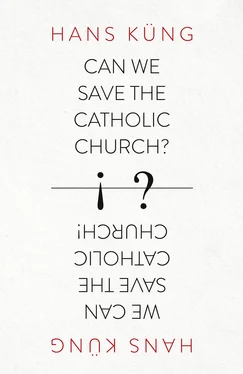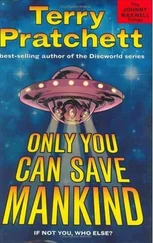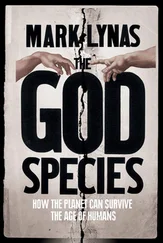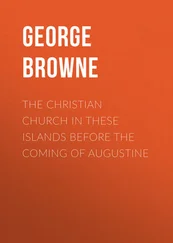Fifty years ago, Joseph Ratzinger and I were the two youngest official advisors to the Second Vatican Council (1962–5). That Council tried to reform important elements of the Roman system, but, unfortunately, the stubborn resistance of the Roman Curia managed by and large to hamper these efforts and to restrict their success. In the decades since the Council, Rome has gradually been turning back the clock on the proposals for reform and renewal, and this has in turn led to a renewed outbreak of an already rampant and alarming disease in the Catholic Church. The sexual abuse scandals caused by Catholic clergymen are only the latest symptom. The objections to these scandals have become so vehement that, in any other large organization, they would have triggered an intensive investigation into the reasons behind such a tragedy. Not so, however, for the Roman Curia or the Catholic episcopate! At first, Rome and the episcopate simply denied any share in the responsibility for the systematic cover-up of these cases. And, when that strategy failed, they have, with very few exceptions, shown little interest in uncovering the deep historical and systemic reasons for such horrific aberrations.
The regrettable refusal to look at the causes of this sickness compels me to bring out into the open the historical truth about the Christian Church, starting from its origins – in the face of all the current attempts to forget, conceal and cover them up. For people with little detailed historical education, for traditional Catholic readers, and possibly even for some bishops, these facts will undoubtedly prove frightening and disillusioning. Someone who has never been seriously confronted with historical facts of this kind will certainly be dismayed to learn how things have been done over long periods of time and how all too human so many Church institutions and constitutions – particularly the core Roman Catholic institution of the papacy – are.
However, there is also a positive side to these disappointing and disillusioning facts: they show that the Church’s institutions and its character – beginning with the papacy – can in fact be changed, even fundamentally reformed. The papacy need not be abolished, but it should be renewed in such a way that the Petrine ministry once again becomes the office in the succession to St Peter described in the Bible. However, what does need to be abolished is the Medieval Roman system of governance and control. My critical destruction is therefore done in the service of committed construction, of reform and renewal, in the hope that, despite all appearances to the contrary, the Catholic Church will remain viable into the third millennium.
Many readers will be surprised that I use so many medical metaphors in this book. This is because, in terms of health and disease, similarities between the body corporate of the Catholic Church and the human organism immediately spring to mind. Moreover, using medical language in analysing the Church’s condition allows me to formulate certain truths more clearly than if I were to use legal language. I do not see myself as a judge, but rather – in the broadest sense of the term – as a kind of physician.
My fundamental criticism of the Roman System is grave, and I will give my reasons for it, point by point. I will attempt, to the best of my knowledge and in all conscience, to make an honest diagnosis throughout this book and to offer effective suggestions for treatment. Doubtlessly, the medicine will often be bitter, but the Church requires such medicine if it hopes to recover. The story I tell here is a gripping one, and – as is usually the case with descriptions of progressive disease – it is hardly pleasant. But I have not described my diagnosis so explicitly simply because I testily insist on being right or because I enjoy being contentious, but only to fulfil my duty in conscience to offer this service (possibly my last?) to my Church, a Church which I have endeavoured to serve all my life.
Based on my previous experience, I expect that Rome will do everything it can, if not to condemn such an uncomfortable and inconvenient book, then at least to keep it as far as possible under wraps. I hope, however, that this book will receive support from within the church community and from the public at large, in particular from theologians and, if possible, also from those bishops who genuinely wish for change. I also hope that this book will shake up those who are ideologically hidebound, and awaken the legally and financially entrenched Roman hierarchy from its complacent slumber, so that they will at least begin to take note of the pathogenesis presented here and to give thought to my explanation of how the disease from which the Catholic Church is suffering has developed, and of the consequences of this disease, so that they will not obstruct the unpleasant but urgently necessary therapy.
What a wonderful way this would be to mark the fiftieth anniversary of the prophetic Second Vatican Council! While not everything can be healed overnight, the agenda set forth here will, I am convinced, remain on the table as an important order of business for the Catholic Church in the coming years. And if that is the case, all of my effort has been worthwhile.
Конец ознакомительного фрагмента.
Текст предоставлен ООО «ЛитРес».
Прочитайте эту книгу целиком, купив полную легальную версию на ЛитРес.
Безопасно оплатить книгу можно банковской картой Visa, MasterCard, Maestro, со счета мобильного телефона, с платежного терминала, в салоне МТС или Связной, через PayPal, WebMoney, Яндекс.Деньги, QIWI Кошелек, бонусными картами или другим удобным Вам способом.












